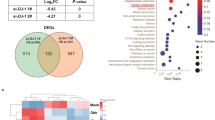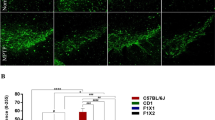Abstract
The canonical Wnt pathway is critical for both the development and adulthood survival and homeostatic maintenance of the midbrain dopaminergic (DA) neurons. Expanding evidence has demonstrated that genetic factors associated with familial Parkinson disease (PD) deregulate this important pathway, suggesting that a disturbed canonical Wnt pathway is likely involved in PD pathogenesis; yet, the specific role of this pathway in sporadic PD remains unclear. In this study, we aimed to determine the effects of specific inhibition of the canonical pathway by hemizygous knockout of β-catenin, the obligatory component of the canonical Wnt pathway, on paraquat (PQ)-induced DA neuronal degeneration in the substantia nigra in vivo. We found that while hemizygous conditional knockout of β-catenin in DA neurons did not cause any significant TH+ neuronal loss in the substantia nigra at basal level, it triggered elevated oxidative stress at basal level and further enhanced PQ-induced oxidative damage and loss of TH+ neurons in the substantia nigra and axonal termini in the striatum that manifested as exacerbated motor deficits. These data support the notion that reduced Wnt/β-catenin signaling in sporadic PD likely contributes to DA neuronal loss through an enhanced oxidative stress-response pathway.








Similar content being viewed by others
Abbreviations
- DA:
-
Dopaminergic
- DAT:
-
Dopamine transporter
- 4-HNE:
-
4-Hydroxynonenal
- JNKs:
-
c-Jun N-terminal kinases
- KO:
-
Knockout
- MPTP:
-
1-Methyl-4-phenyl-1,2,3,6-tetrahydropyridine
- PQ:
-
Paraquat
- PD:
-
Parkinson disease
- ROS:
-
Reactive oxygen species
- SN:
-
Substantia nigra pars compacta
- TH:
-
Tyrosine hydroxylase
- Tg:
-
Transgenic
- VTA:
-
Ventral tegmental
References
Jankovic J (2008) Parkinson's disease: clinical features and diagnosis. J Neurol Neurosurg Psychiatry 79(4):368–376. https://doi.org/10.1136/jnnp.2007.131045
Schapira AH (1997) Pathogenesis of Parkinson’s disease. Baillieres Clin Neurol 6(1):15–36
Domingo A, Klein C (2018) Genetics of Parkinson disease. Handb Clin Neurol 147:211–227. https://doi.org/10.1016/B978-0-444-63233-3.00014-2
Dauer W, Przedborski S (2003) Parkinson's disease: mechanisms and models. Neuron 39(6):889–909
Priyadarshi A, Khuder SA, Schaub EA, Shrivastava S (2000) A meta-analysis of Parkinson’s disease and exposure to pesticides. Neurotoxicology 21(4):435–440
Van Maele-Fabry G, Hoet P, Vilain F, Lison D (2012) Occupational exposure to pesticides and Parkinson’s disease: a systematic review and meta-analysis of cohort studies. Environ Int 46:30–43. https://doi.org/10.1016/j.envint.2012.05.004
Liou HH, Tsai MC, Chen CJ, Jeng JS, Chang YC, Chen SY, Chen RC (1997) Environmental risk factors and Parkinson’s disease: a case-control study in Taiwan. Neurology 48(6):1583–1588
Pezzoli G, Cereda E (2013) Exposure to pesticides or solvents and risk of Parkinson disease. Neurology 80(22):2035–2041. https://doi.org/10.1212/WNL.0b013e318294b3c8
Freire C, Koifman S (2012) Pesticide exposure and Parkinson’s disease: epidemiological evidence of association. Neurotoxicology 33(5):947–971. https://doi.org/10.1016/j.neuro.2012.05.011
Yan MH, Wang X, Zhu X (2013) Mitochondrial defects and oxidative stress in Alzheimer disease and Parkinson disease. Free Radic Biol Med 62:90–101. https://doi.org/10.1016/j.freeradbiomed.2012.11.014
Garcia-Velazquez L, Arias C (2017) The emerging role of Wnt signaling dysregulation in the understanding and modification of age-associated diseases. Ageing Res Rev 37:135–145. https://doi.org/10.1016/j.arr.2017.06.001
MacDonald BT, Tamai K, He X (2009) Wnt/beta-catenin signaling: components, mechanisms, and diseases. Dev Cell 17(1):9–26. https://doi.org/10.1016/j.devcel.2009.06.016
Castelo-Branco G, Wagner J, Rodriguez FJ, Kele J, Sousa K, Rawal N, Pasolli HA, Fuchs E et al (2003) Differential regulation of midbrain dopaminergic neuron development by Wnt-1, Wnt-3a, and Wnt-5a. Proc Natl Acad Sci U S A 100(22):12747–12752. https://doi.org/10.1073/pnas.1534900100
Joksimovic M, Awatramani R (2014) Wnt/beta-catenin signaling in midbrain dopaminergic neuron specification and neurogenesis. J Mol Cell Biol 6(1):27–33. https://doi.org/10.1093/jmcb/mjt043
Prakash N, Brodski C, Naserke T, Puelles E, Gogoi R, Hall A, Panhuysen M, Echevarria D et al (2006) A Wnt1-regulated genetic network controls the identity and fate of midbrain-dopaminergic progenitors in vivo. Development 133(1):89–98. https://doi.org/10.1242/dev.02181
Fukusumi Y, Meier F, Gotz S, Matheus F, Irmler M, Beckervordersandforth R, Faus-Kessler T, Minina E et al (2015) Dickkopf 3 promotes the differentiation of a rostrolateral midbrain dopaminergic neuronal subset in vivo and from pluripotent stem cells in vitro in the mouse. J Neurosci 35(39):13385–13401. https://doi.org/10.1523/JNEUROSCI.1722-15.2015
Salasova A, Yokota C, Potesil D, Zdrahal Z, Bryja V, Arenas E (2017) A proteomic analysis of LRRK2 binding partners reveals interactions with multiple signaling components of the WNT/PCP pathway. Mol Neurodegener 12(1):54. https://doi.org/10.1186/s13024-017-0193-9
Berwick DC, Harvey K (2012) LRRK2 functions as a Wnt signaling scaffold, bridging cytosolic proteins and membrane-localized LRP6. Hum Mol Genet 21(22):4966–4979. https://doi.org/10.1093/hmg/dds342
Berwick DC, Javaheri B, Wetzel A, Hopkinson M, Nixon-Abell J, Granno S, Pitsillides AA, Harvey K (2017) Pathogenic LRRK2 variants are gain-of-function mutations that enhance LRRK2-mediated repression of beta-catenin signaling. Mol Neurodegener 12(1):9. https://doi.org/10.1186/s13024-017-0153-4
Eaton S (2008) Retromer retrieves wntless. Dev Cell 14(1):4–6. https://doi.org/10.1016/j.devcel.2007.12.014
Rawal N, Corti O, Sacchetti P, Ardilla-Osorio H, Sehat B, Brice A, Arenas E (2009) Parkin protects dopaminergic neurons from excessive Wnt/beta-catenin signaling. Biochem Biophys Res Commun 388(3):473–478. https://doi.org/10.1016/j.bbrc.2009.07.014
Hofmann JW, McBryan T, Adams PD, Sedivy JM (2014) The effects of aging on the expression of Wnt pathway genes in mouse tissues. Age 36(3):9618. https://doi.org/10.1007/s11357-014-9618-3
Bayod S, Felice P, Andres P, Rosa P, Camins A, Pallas M, Canudas AM (2015) Downregulation of canonical Wnt signaling in hippocampus of SAMP8 mice. Neurobiol Aging 36(2):720–729. https://doi.org/10.1016/j.neurobiolaging.2014.09.017
Zhang L, Deng J, Pan Q, Zhan Y, Fan JB, Zhang K, Zhang Z (2016) Targeted methylation sequencing reveals dysregulated Wnt signaling in Parkinson disease. J Genet Genomics 43(10):587–592. https://doi.org/10.1016/j.jgg.2016.05.002
Brault V, Moore R, Kutsch S, Ishibashi M, Rowitch DH, McMahon AP, Sommer L, Boussadia O et al (2001) Inactivation of the beta-catenin gene by Wnt1-Cre-mediated deletion results in dramatic brain malformation and failure of craniofacial development. Development 128(8):1253–1264
Wang W, Wang X, Fujioka H, Hoppel C, Whone AL, Caldwell MA, Cullen PJ, Liu J et al (2016) Parkinson’s disease-associated mutant VPS35 causes mitochondrial dysfunction by recycling DLP1 complexes. Nat Med 22(1):54–63. https://doi.org/10.1038/nm.3983
Jiang S, Nandy P, Wang W, Ma X, Hsia J, Wang C, Wang Z, Niu M et al (2018) Mfn2 ablation causes an oxidative stress response and eventual neuronal death in the hippocampus and cortex. Mol Neurodegener 13(1):5. https://doi.org/10.1186/s13024-018-0238-8
Fujita K, Seike T, Yutsudo N, Ohno M, Yamada H, Yamaguchi H, Sakumi K, Yamakawa Y et al (2009) Hydrogen in drinking water reduces dopaminergic neuronal loss in the 1-methyl-4-phenyl-1,2,3,6-tetrahydropyridine mouse model of Parkinson’s disease. PLoS One 4(9):e7247. https://doi.org/10.1371/journal.pone.0007247
Dai TL, Zhang C, Peng F, Niu XY, Hu L, Zhang Q, Huang Y, Chen L et al (2014) Depletion of canonical Wnt signaling components has a neuroprotective effect on midbrain dopaminergic neurons in an MPTP-induced mouse model of Parkinson’s disease. Exp Ther Med 8(2):384–390. https://doi.org/10.3892/etm.2014.1745
Brooks AI, Chadwick CA, Gelbard HA, Cory-Slechta DA, Federoff HJ (1999) Paraquat elicited neurobehavioral syndrome caused by dopaminergic neuron loss. Brain Res 823(1–2):1–10
Selley ML (1998) (E)-4-hydroxy-2-nonenal may be involved in the pathogenesis of Parkinson’s disease. Free Radic Biol Med 25(2):169–174
McCormack AL, Atienza JG, Johnston LC, Andersen JK, Vu S, Di Monte DA (2005) Role of oxidative stress in paraquat-induced dopaminergic cell degeneration. J Neurochemy 93(4):1030–1037. https://doi.org/10.1111/j.1471-4159.2005.03088.x
Choi WS, Abel G, Klintworth H, Flavell RA, Xia Z (2010) JNK3 mediates paraquat- and rotenone-induced dopaminergic neuron death. J Neuropathol Exp Neurol 69(5):511–520. https://doi.org/10.1097/NEN.0b013e3181db8100
Hunot S, Vila M, Teismann P, Davis RJ, Hirsch EC, Przedborski S, Rakic P, Flavell RA (2004) JNK-mediated induction of cyclooxygenase 2 is required for neurodegeneration in a mouse model of Parkinson’s disease. Proc Natl Acad Sci U S A 101(2):665–670. https://doi.org/10.1073/pnas.0307453101
Zhao F, Wang W, Wang C, Siedlak SL, Fujioka H, Tang B, Zhu X (2017) Mfn2 protects dopaminergic neurons exposed to paraquat both in vitro and in vivo: implications for idiopathic Parkinson’s disease. Biochim Biophys Acta 1863(6):1359–1370. https://doi.org/10.1016/j.bbadis.2017.02.016
L'Episcopo F, Tirolo C, Testa N, Caniglia S, Morale MC, Cossetti C, D'Adamo P, Zardini E et al (2011) Reactive astrocytes and Wnt/beta-catenin signaling link nigrostriatal injury to repair in 1-methyl-4-phenyl-1,2,3,6-tetrahydropyridine model of Parkinson’s disease. Neurobiol Dis 41(2):508–527. https://doi.org/10.1016/j.nbd.2010.10.023
L'Episcopo F, Serapide MF, Tirolo C, Testa N, Caniglia S, Morale MC, Pluchino S, Marchetti B (2011) A Wnt1 regulated Frizzled-1/beta-catenin signaling pathway as a candidate regulatory circuit controlling mesencephalic dopaminergic neuron-astrocyte crosstalk: therapeutical relevance for neuron survival and neuroprotection. Mol Neurodegener 6:49. https://doi.org/10.1186/1750-1326-6-49
Dun Y, Li G, Yang Y, Xiong Z, Feng M, Wang M, Zhang Y, Xiang J et al (2012) Inhibition of the canonical Wnt pathway by Dickkopf-1 contributes to the neurodegeneration in 6-OHDA-lesioned rats. Neurosci Lett 525(2):83–88. https://doi.org/10.1016/j.neulet.2012.07.030
Gollamudi S, Johri A, Calingasan NY, Yang L, Elemento O, Beal MF (2012) Concordant signaling pathways produced by pesticide exposure in mice correspond to pathways identified in human Parkinson’s disease. PLoS One 7(5):e36191. https://doi.org/10.1371/journal.pone.0036191
Wei L, Ding L, Mo MS, Lei M, Zhang L, Chen K, Xu P (2015) Wnt3a protects SH-SY5Y cells against 6-hydroxydopamine toxicity by restoration of mitochondria function. Transl Neurodegener 4:11. https://doi.org/10.1186/s40035-015-0033-1
Wei L, Sun C, Lei M, Li G, Yi L, Luo F, Li Y, Ding L et al (2013) Activation of Wnt/beta-catenin pathway by exogenous Wnt1 protects SH-SY5Y cells against 6-hydroxydopamine toxicity. J Mol Neurosci 49(1):105–115. https://doi.org/10.1007/s12031-012-9900-8
Essers MA, de Vries-Smits LM, Barker N, Polderman PE, Burgering BM, Korswagen HC (2005) Functional interaction between beta-catenin and FOXO in oxidative stress signaling. Science 308(5725):1181–1184. https://doi.org/10.1126/science.1109083
Lento W, Ito T, Zhao C, Harris JR, Huang W, Jiang C, Owzar K, Piryani S et al (2014) Loss of beta-catenin triggers oxidative stress and impairs hematopoietic regeneration. Genes Dev 28(9):995–1004. https://doi.org/10.1101/gad.231944.113
Liu P, Su J, Song X, Wang S (2017) Activation of nuclear beta-catenin/c-Myc axis promotes oxidative stress injury in streptozotocin-induced diabetic cardiomyopathy. Biochem Biophys Res Commun 493(4):1573–1580. https://doi.org/10.1016/j.bbrc.2017.10.027
Pacelli C, Giguere N, Bourque MJ, Levesque M, Slack RS, Trudeau LE (2015) Elevated mitochondrial bioenergetics and axonal arborization size are key contributors to the vulnerability of dopamine neurons. Curr Biol 25(18):2349–2360. https://doi.org/10.1016/j.cub.2015.07.050
Funding
This research was partly supported by the National Institute of Health [grant number NS083498 (to X. Zhu)], the Dr. Robert M. Kohrman Memorial Fund (to X. Zhu), the National Natural Science Foundation of China [No. 81430023 (to B. Tang)], the National Key Plan for Scientific Research and Development of China [No. 2016YFC1306000 (to B. Tang)], and the NSFC-NIH joint program [No. 81361120404 (to B. Tang)].
Author information
Authors and Affiliations
Contributions
FZ designed/carried out experiments, collected data and wrote the manuscript, SLS, SLR QX, BT contributed to interpretation of results and provided feedback on the manuscript. BT and XZ conceived the project. XZ directed the project, interpret results and wrote the manuscript. All authors had final approval of the submitted version.
Corresponding authors
Ethics declarations
Conflict of Interest
The authors declare that they have no conflict of interest.
Additional information
Publisher’s Note
Springer Nature remains neutral with regard to jurisdictional claims in published maps and institutional affiliations.
Rights and permissions
About this article
Cite this article
Zhao, F., Siedlak, S.L., Torres, S.L. et al. Conditional Haploinsufficiency of β-Catenin Aggravates Neuronal Damage in a Paraquat-Based Mouse Model of Parkinson Disease. Mol Neurobiol 56, 5157–5166 (2019). https://doi.org/10.1007/s12035-018-1431-z
Received:
Accepted:
Published:
Issue Date:
DOI: https://doi.org/10.1007/s12035-018-1431-z




